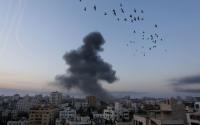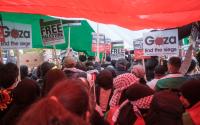International Herald Tribune, November 22, 2001
WASHINGTON With opposition rebels in control of nearly three-quarters of Afghanistan, Pentagon officials say the war is entering a distinctly new phase that may last longer and prove far more difficult for U.S. forces than the surprisingly swift advances of the first six weeks.Despite all the talk at the Pentagon of an unconventional war, much of the action has resembled a very conventional conflict, with Northern Alliance fighters carrying out set-piece advances aided by U.S. air strikes. But the fighting in the south promises to resemble classic guerrilla war, experts said.As described by military planners and experts outside the government, the next phase will be murkier, lacking definable front lines, with U.S. forces pursuing small groups of Taliban leaders and members of Osama bin Laden's Qaida terror network.Progress sometimes will be difficult to detect. There almost certainly will be less U.S. bombing, and the campaign will be characterized by stretches of apparent inaction punctuated by lightning raids by covert troops. It could involve U.S. casualties from sniping, land-mine explosions and perhaps even terrorist attacks.Most of all, it may be far more difficult to tell when - or if - the United States has won. Whether Mr. bin Laden is caught and killed any time soon, the Bush administration has vowed to root out the entire Qaida network in Afghanistan, a process that will require probing the remote and isolated mountains and empty deserts of the south."The south will be much different than the north," concluded one officer from U.S. special forces, commonly known as the Green Berets. Several hundred special forces troops are in Afghanistan, according to the Pentagon.In tactics and perhaps even in duration, the closest analogy to the U.S. effort may be the anti-guerrilla war in El Salvador in the 1980s, said another special forces officer. In that shadowy struggle, a small number of U.S. special forces advisers worked with local forces on the ground to hunt down and kill Marxist guerrillas - much as they are doing with Afghan rebels in their campaign against the Taliban and Qaida.As in El Salvador, the U.S. military effort in Afghanistan is paralleled by a major CIA operation that at times is more significant than the overt military mission. The CIA has been operating in southern Afghanistan for nearly 18 months, according to well-informed sources, but in recent weeks it has stepped up its efforts to undermine the Taliban politically and target Qaida members.The duration of the next phase clearly is on the minds of President George W. Bush and his top advisers this week. "We have made great progress there, but there's still a lot of work to do, and the degree of difficulty is increasing as we work hard to achieve our objectives," Mr. Bush said Monday. "It may take longer than some anticipate."Underscoring the president's assessment, the Pentagon is continuing to pour troops, ships and airplanes into the region around Afghanistan. Two Marine Expeditionary Units, carrying several thousand Marines, are now off the coast of Pakistan. The unmanned Global Hawk long-range reconnaissance aircraft is said to have begun flying over Afghanistan this week, providing the Pentagon with detailed photo images and other intelligence data. More than 1,000 light infantry soldiers from the 10th Mountain Division, who could be used as a quick reaction force, are based in Uzbekistan, and an undetermined number of special operations personnel are in Pakistan."We have great capabilities, we have them in place, and we have great flexibility operationally," a Pentagon official said, assessing the current U.S. military posture. "We can afford to remain flexible and see how things play out."Some independent analysts predict that the hunt will be over before the United States needs to use all the new forces. "I would expect we nail Osama bin Laden within the next 10 to 14 days. He is now very vulnerable," said Robert Cook, a military historian who served with special forces in Vietnam. "Bin Laden and al Qaida appear to have been taken by surprise at the collapse of the Taliban. That could be a big edge for us."But the closer officials are to the action, the more cautious they sound about the war in the south, the Taliban stronghold where Mr. bin Laden is believed to be hiding. "We're going to be in this business for a long time," said a senior military planner. "There are a lot of really difficult days ahead."Whether the war lasts six more weeks or six more months is anyone's guess. Visiting the site of the World Trade Center a week ago, Defense Secretary Donald Rumsfeld underscored the uncertain nature of the next phase of the counterattack on terrorism. "It's different than any that's ever been undertaken," he said. "There is no road map, and so much of it can't be seen as to what's taking place."Charles Fairbanks, a Central Asia expert at Johns Hopkins University, said that renegade Taliban units could remain active in southern Afghanistan for a long time, threatening U.S. forces and other Westerners. "I think some small segments will still be Talibanists, and will still strike out for years to come," he said. He added that if squabbling broke out among Afghanistan's numerous ethnic and tribal groups, the Taliban could even take back some territory.Some similarities to the first part of the war are likely to remain. As in the north, the U.S. military appears to be taking an improvisational approach. Rather than proceeding in a linear fashion through a set of diagrammed plans, the Pentagon approach is to acquire information, act upon it, assess the effects of that action, and then decide what to do next."I think you're going to have to continue to fly every day," a defense official added. "You're going to need the best intelligence you can get, which will mean putting more of the special forces guys on the ground, and you're going to have to go door to door and cave to cave, and calling in the airplanes by saying, 'I've got a target - come and get it.'"But operating on the ground in southern Afghanistan could prove more complicated than that, for several reasons.Afghanistan is one of the most heavily land-mined countries in the world, and the Taliban heartland around Kandahar is one of the most heavily mined parts of Afghanistan, said James Dalton, an expert on the agriculture of that area. While the U.S. military possesses a lot of high-tech weaponry, it has yet to field gear that enables quick detection and avoidance of anti-personnel mines.Also, southwestern Afghanistan is a particularly combative part of a country where guerrilla warfare is almost the national sport. The region of the southwest around the Helmand River is the major opium-producing part of the country, Mr. Dalton noted."Local well-armed warlords desired control over the development and the marketing of the crops, so there was much fighting between these various groups in the area," Mr. Dalton said.Negotiations with competing factions over the future government of Afghanistan, which the United Nations is trying to arrange with U.S. support, are likely to muddy the image of the war, said retired Air Force Colonel Sam Gardiner, an expert on military strategy."This war began as an argument between good and evil," he said. "As the political situation becomes complicated, the distinctions will blur."






